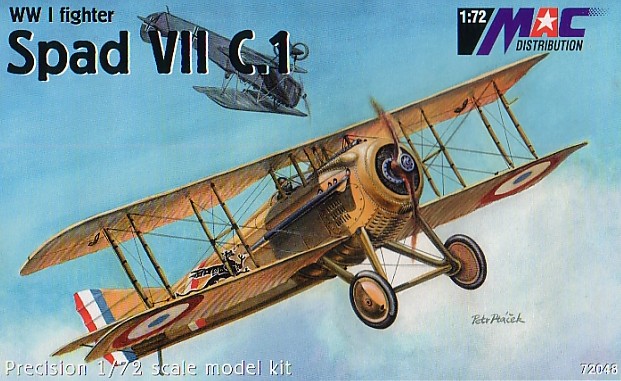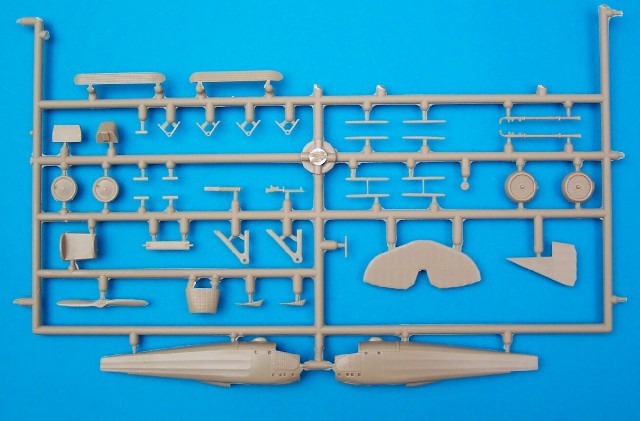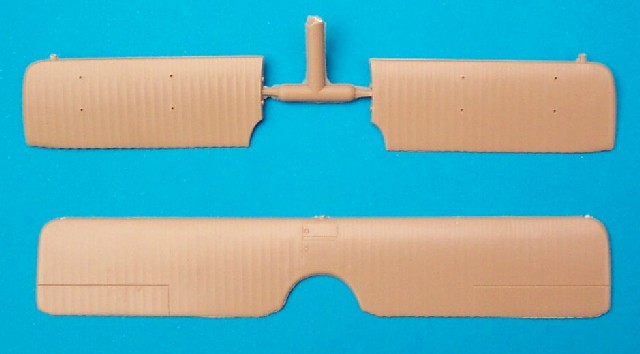|
SPAD VII C.1

MAC 1/72
S
u m m a r y
|
| Catalogue Number: |
Spad VII C.1 kit No.
72048 |
| Scale: |
1/72 |
| Contents and Media: |
44 parts in tan coloured
resin |
| Price: |
USD$18.97 from Squadron.com
|
| Review Type: |
FirstLook |
| Advantages: |
Sharp detail, good use
of p-e, acetate windscreens, accurate moulds, lovely decal sheet. |
| Disadvantages: |
Wing trailing edges may
bother some modelers. |
| Recommendation: |
Recommended |
Reviewed by Robert Baumgartner

Mac's
1/72 scale SPAD VII C.1
is available online from Squadron.com
Louis Béchereau was a talented designer and before the war had created
the superb Deperdussin monoplanes. Now he was working for the Société
anonyme pour l’Aviation et ses Dérivés and decided to build an aircraft
around the new 150hp Hispano- Suiza 8A engine.
This water-cooled V8 engine was designed by Swiss engineer Marc Birkigt
and was to become a landmark in the thinking of future aircraft engines.
Béchereau’s brainchild was to receive the official designation of Spa. 7 C
1.
Problems with the manufacture of radiators slowed production of the
aircraft and by the end of 1916, less than 200 had been delivered to the
front.
Other French companies were given contracts to try and speed things up
but this was only marginally successful.
The reputation of the Spad 7 was one of sturdiness and was to be well
liked by its French pilots. Eventually about 3500 aircraft were produced
and were to serve with British, Italian, Belgian and American Units during
the war.
After WWI many other air forces employed this fighter, which is testimony
to the soundness of the original design.
Inside the box we find a single sprue that holds 44 tan coloured
plastic parts.

These are very well moulded with crisp, sharp detail and virtually no
flash.
Not all parts are used and the inclusion of skis suggests that Mac
intend to release a Russian version.
 It’s
good to see that Mac is the supplying the usual bonus of a photo-etched
fret. In this case it comprises of 14 parts, which include seat belts,
instrument panel with cockpit shelf, rudder bar, pilot’s footstep and
aileron bell cranks! It’s
good to see that Mac is the supplying the usual bonus of a photo-etched
fret. In this case it comprises of 14 parts, which include seat belts,
instrument panel with cockpit shelf, rudder bar, pilot’s footstep and
aileron bell cranks!
Thoughtfully, the windscreen is not forgotten with an acetate sheet
providing three different styles. This is very comprehensive.
The wings exhibit beautifully subtle rib detail, not the overdone hills
and valleys of Spads from previous decades. The outlines are good but can
be improved by a slight sanding near the lower wing cut out. This is to
show the trailing edge “cut corner” that leads into the wing root “cut
out”. Mac’s own plans, which are included in the instruction sheet, show
this feature very well.

The manufacturing techniques used mean that the trailing edges are a
little thicker than we are used to from some other companies. Therefore
those modelers wishing to thin them should do so from below to minimize
the visual cost of loosing all that lovely detail.
Both shuttered and un-shuttered radiator noses are provided and the detail
here is quite exquisite. They attach to well moulded fuselage halves,
which contain some structural detail on the inside. The detail here is
also very sharp and a dry fit reveals that a smooth assembly is assured.
If you use Ian Stair’s drawings in Windsock Datafile #8, it appears that
the fuselage is a tad short between the tail plane and the start of the
rudder. This is nothing to worry about, as it is not noticeable on the
finished model.
Items such as struts and exhaust pipes are nicely done but the Vickers
machine gun lacks a few features. Scrap plastic strip can help out here.
The cockpit area is well furnished for this scale and this is where the
aforementioned p-e really helps. The characteristic shelf is in this
material and the supplied seat belts add the finishing touch.
Markings are supplied for three aircraft on a beautifully printed decal
sheet. Everything was in perfect register and only minimal carrier film is
evident around the images.
Option 1 - Spad 7 (serial S 1544)
Capitano Giorgio Pessi, 91ª.Squadriglia, July 1917.
Pessi’s victories were all scored while serving with the 91ª,
including the Austrian ace Ltn. Szepessy-Sokoll, and all were in a Spad
7. After the war he went to America as a pilot for their Ca.5 program
and actually flew a bomber under the Brooklyn Bridge!
Later in life he joined an airline company and was lost flying over
the sea in 1933.
Option 2 - Spad 7 (serial S 122)
Lt. Armand Pinsard, Escadrille N.26, August 1916.
Pinsard was unfortunate enough to be forced down in enemy territory
on 8 February 1915 when with Escadrille MS23. He was taken prisoner and
made numerous attempts to breakout during his 14 months of captivity.
Finally on the 26th April, he succeeded in escaping with his friend
Capitaine Victor Menard and made it to safety on the 10th April. After
some recuperation, he again flew in combat scoring one victory with
Escadrille N26, 15 with Escadrille N78 and 11 with Escadrille Spa23.
Pinsard finished the war with at least 27 aerial conquests including 9
balloons.
Option 3 - Spad 7 (serial S 1379)
Adj. Marcel Henriot, Spa.65
Henriot scored at least six victories, scoring most of them with
Spa.65.
He survived the war and died in Nantes in November 1952.
Mac is to be applauded for coming out with what is a very good effort
in this scale. Excellent use has been made of the p-e and the supplied
acetate windscreens will add extra finesse to the finished product.
Due to the wide range of markings applied to the Spad 7, we can expect
many more versions of this kit to appear and I’m looking forward to all
of them.
Recommended.
Thanks to
Squadron.com for the review
sample.
Review and Images Copyright © 2004 by
Robert Baumgartner
Page Created 17 February, 2004
Last updated 12 August, 2004
Back to HyperScale Main Page
Back to Reviews Page
|
Home | What's
New | Features
| Gallery |
Reviews | Reference
| Forum
| Search